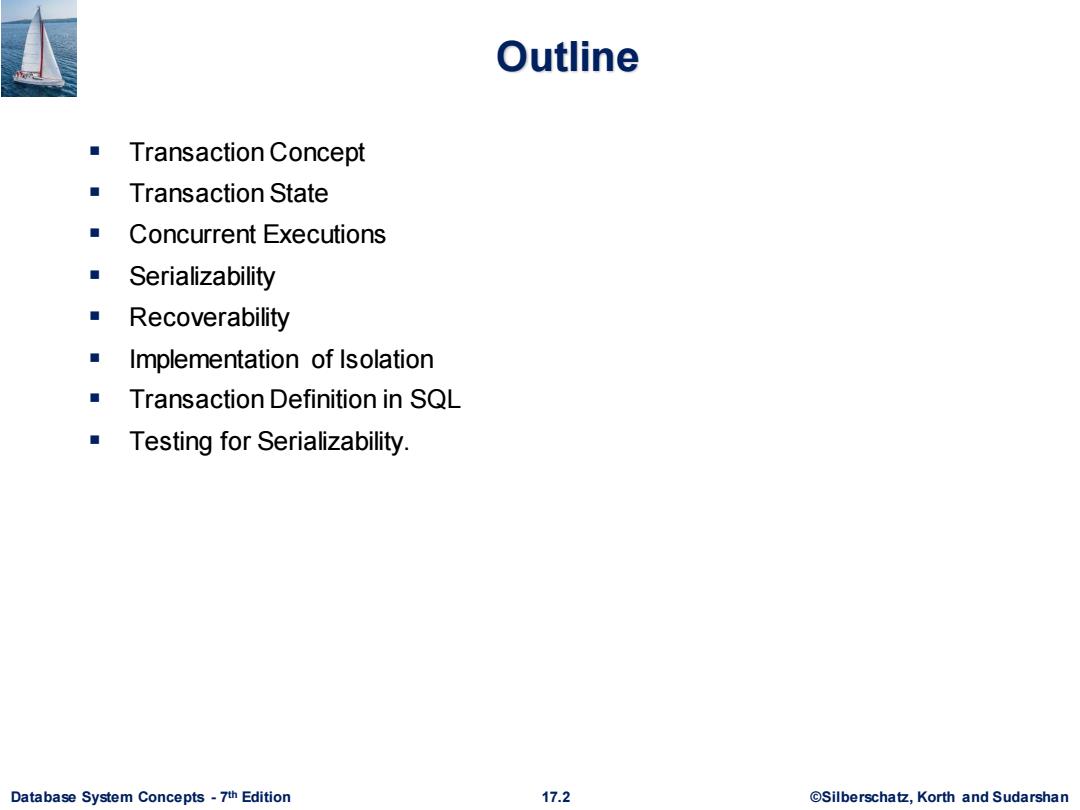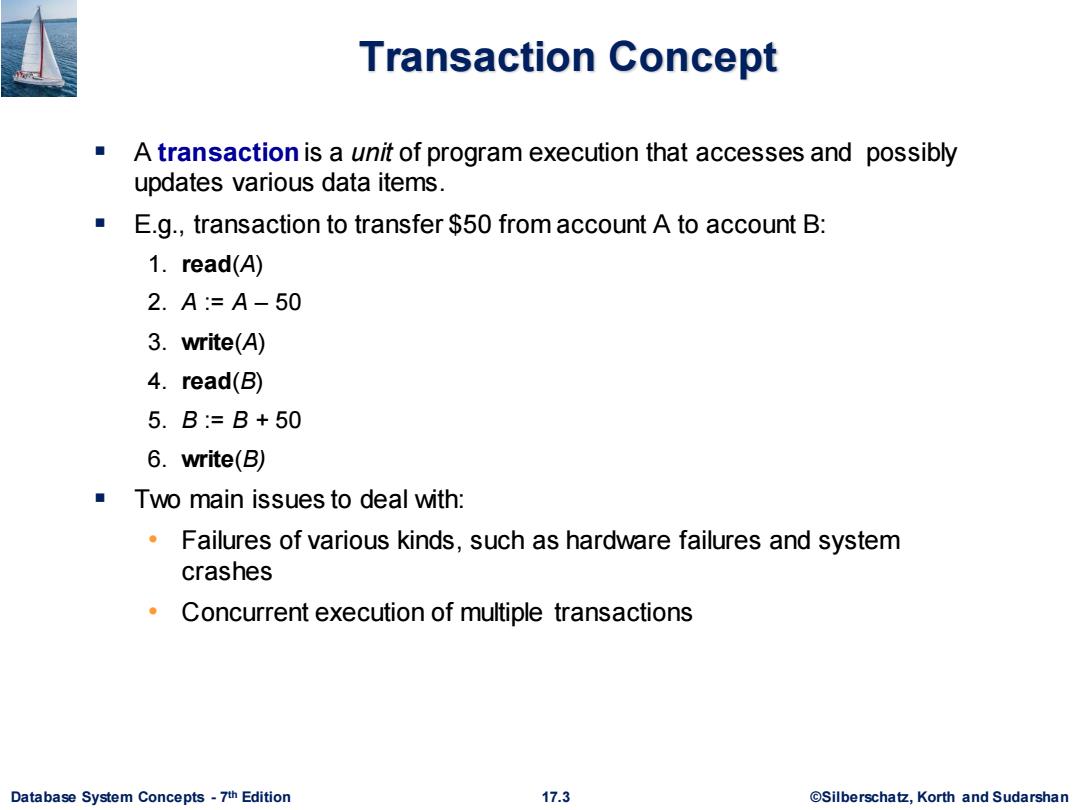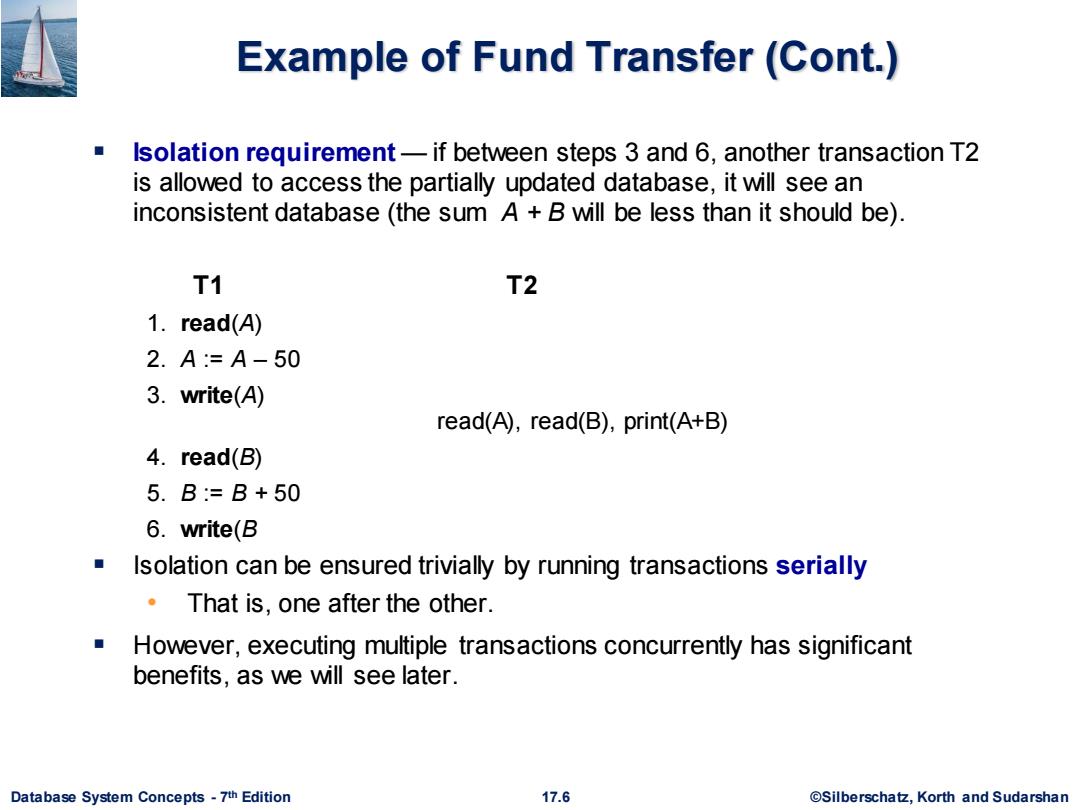
Outline ■Transaction Concept ■Transaction State Concurrent Executions Serializability ■ Recoverability Implementation of Isolation Transaction Definition in SQL Testing for Serializability. Database System Concepts-7th Edition 17.2 @Silberschatz,Korth and Sudarshan
Database System Concepts - 7 17.2 ©Silberschatz, Korth and Sudarshan th Edition Outline ▪ Transaction Concept ▪ Transaction State ▪ Concurrent Executions ▪ Serializability ▪ Recoverability ▪ Implementation of Isolation ▪ Transaction Definition in SQL ▪ Testing for Serializability

Transaction Concept A transaction is a unit of program execution that accesses and possibly updates various data items. E.g.,transaction to transfer $50 from account A to account B: 1.read(A) 2.A:=A-50 3.write(A) 4.read(B) 5.B:=B+50 6.write(B) Two main issues to deal with: Failures of various kinds,such as hardware failures and system crashes Concurrent execution of multiple transactions Database System Concepts-7th Edition 17.3 ©Silberscha乜,Korth and Sudarshan
Database System Concepts - 7 17.3 ©Silberschatz, Korth and Sudarshan th Edition Transaction Concept ▪ A transaction is a unit of program execution that accesses and possibly updates various data items. ▪ E.g., transaction to transfer $50 from account A to account B: 1. read(A) 2. A := A – 50 3. write(A) 4. read(B) 5. B := B + 50 6. write(B) ▪ Two main issues to deal with: • Failures of various kinds, such as hardware failures and system crashes • Concurrent execution of multiple transactions

Example of Fund Transfer Transaction to transfer $50 from account A to account B: 1.read(A) 2.A=A-50 3.write(A) 4.read(B) 5.B:=B+50 6.write(B) Atomicity requirement If the transaction fails after step 3 and before step 6,money will be "lost" leading to an inconsistent database state Failure could be due to software or hardware The system should ensure that updates of a partially executed transaction are not reflected in the database Durability requirement-once the user has been notified that the transaction has completed (i.e.,the transfer of the $50 has taken place),the updates to the database by the transaction must persist even if there are software or hardware failures. Database System Concepts-7th Edition 17.4 ©Silberscha乜,Korth and Sudarshan
Database System Concepts - 7 17.4 ©Silberschatz, Korth and Sudarshan th Edition Example of Fund Transfer ▪ Transaction to transfer $50 from account A to account B: 1. read(A) 2. A := A – 50 3. write(A) 4. read(B) 5. B := B + 50 6. write(B) ▪ Atomicity requirement • If the transaction fails after step 3 and before step 6, money will be “lost” leading to an inconsistent database state ▪ Failure could be due to software or hardware • The system should ensure that updates of a partially executed transaction are not reflected in the database ▪ Durability requirement — once the user has been notified that the transaction has completed (i.e., the transfer of the $50 has taken place), the updates to the database by the transaction must persist even if there are software or hardware failures

Example of Fund Transfer (Cont.) Consistency requirement in above example: The sum of A and B is unchanged by the execution of the transaction In general,consistency requirements include Explicitly specified integrity constraints such as primary keys and foreign keys Implicit integrity constraints e.g.,sum of balances of all accounts,minus sum of loan amounts must equal value of cash-in-hand A transaction must see a consistent database. During transaction execution the database may be temporarily inconsistent. When the transaction completes successfully the database must be consistent Erroneous transaction logic can lead to inconsistency Database System Concepts-7th Edition 17.5 ©Silberscha乜,Korth and Sudarshan
Database System Concepts - 7 17.5 ©Silberschatz, Korth and Sudarshan th Edition Example of Fund Transfer (Cont.) ▪ Consistency requirement in above example: • The sum of A and B is unchanged by the execution of the transaction ▪ In general, consistency requirements include • Explicitly specified integrity constraints such as primary keys and foreign keys • Implicit integrity constraints ▪ e.g., sum of balances of all accounts, minus sum of loan amounts must equal value of cash-in-hand • A transaction must see a consistent database. • During transaction execution the database may be temporarily inconsistent. • When the transaction completes successfully the database must be consistent ▪ Erroneous transaction logic can lead to inconsistency

Example of Fund Transfer (Cont.) Isolation requirement-if between steps 3 and 6,another transaction T2 is allowed to access the partially updated database,it will see an inconsistent database(the sum A +B will be less than it should be). T1 T2 1.read(A) 2.A:=A-50 3.write(A) read(A),read(B),print(A+B) 4.read(B) 5.B:=B+50 6.write(B Isolation can be ensured trivially by running transactions serially That is,one after the other. However,executing multiple transactions concurrently has significant benefits,as we will see later. Database System Concepts-7th Edition 17.6 @Silberschatz,Korth and Sudarshan
Database System Concepts - 7 17.6 ©Silberschatz, Korth and Sudarshan th Edition Example of Fund Transfer (Cont.) ▪ Isolation requirement — if between steps 3 and 6, another transaction T2 is allowed to access the partially updated database, it will see an inconsistent database (the sum A + B will be less than it should be). T1 T2 1. read(A) 2. A := A – 50 3. write(A) read(A), read(B), print(A+B) 4. read(B) 5. B := B + 50 6. write(B ▪ Isolation can be ensured trivially by running transactions serially • That is, one after the other. ▪ However, executing multiple transactions concurrently has significant benefits, as we will see later